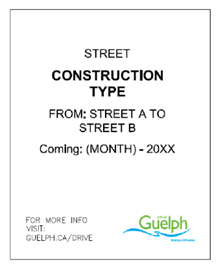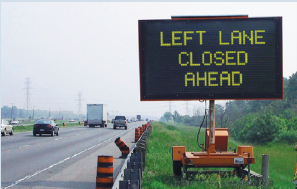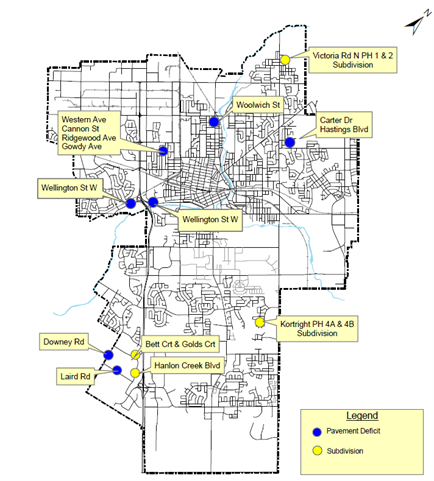On this page
Every year, the City evaluates road conditions and schedules road repairs based on various considerations, such as:
- the condition of the asphalt
- the condition of the sewers and the watermain
- the anticipated reconstruction timeline for the sewers and watermain
- the current level of road maintenance, and
- the volume of traffic
These roads become part of the annual paving program and are scheduled for construction between April and November, as weather allows.
The City prioritizes work in School Zones, which is anticipated to be completed between July 1 and August 31.
Streets included in this year’s program
Pavement deficit
- Western Avenue, Cannon Street, Ridgewood Avenue, Gowdy Avenue
- Wellington Street West
- Downey Road
- Laird Road
- Woolwich Street
- Carter Drive, Hastings Boulevard
Subdivision
- Bell Court and Golds Court
- Hanlon Creek Boulevard
- Victoria Road North PH 1 & 2 Subdivision
- Kortright PH 4A & 4B Subdivision
Components of the Annual Paving Program
Pavement deficit
Pavement deficit refers to the type of work required to repair existing roads depending on the age and condition of the road surface and the underground infrastructure.
Full depth: Full depth resurfacing involves removing all the existing asphalt and rebuilding it from the ground up.
Partial depth: Partial depth resurfacing involves removing and replacing just the surface layer of asphalt on the road to help extend its life cycle.
Roads within subdivisions
The City works to complete roads within subdivision developments at the request of the developer. This work, which is paid for by the developer, involves:
- repairing concrete curb and sidewalk,
- adjusting of manholes and valves,
- repairing asphalt,
- paving new asphalt and installing pavement markings, including any soft boulevard restoration.
Active Transportation
The City is committed to offering options for active transportation. The goal is to encourage more people to cycle, walk, and use public transit. This will help promote healthy, active lives. The Annual Paving Program will support active transportation by installing new infrastructure such as bike lanes and multi-use pathways during road construction.
Traffic calming devices
The City’s Traffic Calming Policy was developed to help address concerns brought forward by members of the community regarding speeding and high vehicle volume in residential neighbourhoods, including School Zones.
The goals of the policy are to improve public safety for all road users, allow streets to function as intended, and encourage active transportation.
The Annual Paving Program expedites the installation of traffic calming devices (i.e., speed cushions/humps) by incorporating installation at the same time as road construction.
Public information and updates
Construction notices are delivered to residents and businesses approximately two weeks ahead of any road construction project.
For major roads and roads with a high volume of traffic, the contractor installs signs notifying road users of the upcoming work a few weeks ahead of scheduled road construction.
Examples of construction information signs


Additional information and updates are available below:
- posted to guelph.ca/construction,
- added to our Google traffic impacts map, and
- shared on the City’s Facebook
The City appreciates your patience and understanding as we complete this important infrastructure project.
For more information
Engineering Services
Engineering and Transportation Services,
519-837-5604
[email protected]

